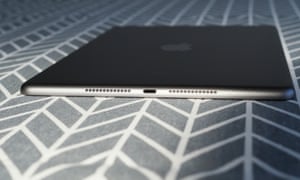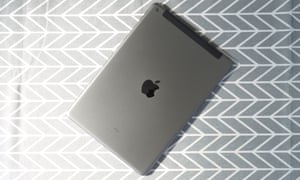Apple’s cheapest iPad just got faster with revamped chips to keep it ahead of the competition.
The eighth-generation iPad costs from GBP329, slotting in under the iPad Mini, iPad Air and iPad Pro lines, yet offering much of the same experience.
The design of the iPad has changed little over the last few years. Apple added a larger 10.2in screen last year, which remains for the 2020 iPad, as do the chunky bezels all around it, the traditional Touch ID home button and aluminium back.

The 10.2in LCD screen is crisp, colourful and bright for the money. It feels a little hollow when you tap on it and flexes when you press a little hard on it, emitting a little puff of air out of the bottom like a squeezy toy. That’s because screen and touch layer aren’t fully laminated together like they are on high-end tablets and most smartphones.
The iPad has features that were once restricted to Apple’s top-of-the-range tablets. It has the Smart Connector on the back for adding an optional Smart Keyboard Folio case (GBP179) and it supports Apple’s first-generation Pencil stylus (GBP89).
There are stereo speakers in the bottom of the tablet, but that means you only get stereo sound in portrait position, not landscape when watching video. They still sound very good and miles better than what you get from most other tablets anywhere near this price. There is also a standard headphone socket in the top, which is missing from the iPad Air and iPad Pro.
The new iPad has the same 8-megapixel rear camera and 1.2-megapixel front-facing camera as previous models. Neither will beat a good smartphone camera, but the front-facing camera runs rings around most laptop webcams for video calls.
Specifications
-
Screen: 10.2in 2160×1620 Retina display (264ppi)
-
Processor: Apple A12 Bionic
-
RAM: 3GB
-
Storage: 32 or 128GB
-
Operating system: iPadOS 14
-
Camera: 8MP rear, 1.2MP selfie camera
-
Connectivity: Wifi 5 (4G optional, eSim), Bluetooth 4.2, Lightning, Touch ID
-
Dimensions: 250.6 x 174.1 x 7.5mm
-
Weight: 490g (4G version: 495g)
Faster performance, 9+ hour battery

The new iPad has Apple’s A12 Bionic chip that debuted in the iPhone XS in 2018. The A12 Bionic replaces the A10 used in the last two versions of the iPad, matching the fifth-generation iPad Mini launched last year.
The new chip is up to 40% faster than the previous one with twice as powerful graphics, but it also contains an AI chip, which speeds up tasks based on machine learning such as handwriting recognition and image manipulation.
Overall the chip makes for a considerable performance boost for the low-end iPad, and makes it considerably more powerful than most of its competition. But the iPad lacks support for both the latest wifi 6 and Bluetooth 5 standards, which have become commonplace in both tablets and smartphones over the past couple of years.
Battery life varies slightly based on what you’re doing. The tablet lasts more than nine hours while watching video stored offline with medium to high brightness, and for a similar length of time when using productivity and browsing apps for a bit of work. Playing games drains the battery faster.
The iPad ships with a compact 20W USB-C charger and a USB-C to Lightning cable and takes three hours to fully charge. It can also be charged with older USB-A Lightning cables and power adapters.
Sustainability
Apple does not give a rated lifecycle for the iPad battery, typically 500 full-charge cycles, but it can be replaced for GBP99. The tablet is generally repairable, with an out-of-warranty service costing GBP 246.44, which includes the screen. The previous-generation iPad was only awarded a two out of 10 for repairability by the specialist iFixit.
The iPad uses 100% recycled aluminium in its case, 100% recycled tin in the solder of its main board and at least 60% recycled plastic in multiple other components. Apple is also using renewable energy for final assembly of the machine, and breaks down the tablet’s environmental impact in its report.
Apple also offers trade-in and free recycling schemes, including for non-Apple products.
iPadOS 14

Apple’s iPadOS 14 is the best mobile-tablet software available, offering a balance of utility, entertainment and broad app support unrivalled by Windows 10 or Android. You can also expect at least five years of software support from Apple, so you can safely use the iPad for longer than its competitors.
The interface has been revamped this year with new home-screen widgets for at-a-glance information such as upcoming appointments, battery life, Google search and other data from third-party apps. The updated universal search now works more like the excellent Spotlight on a Mac, allowing you to search for data in apps, launch apps, find emails and search the web from a quick pop-up box. Apple’s apps and toolbars are more like a computer too with toolbars, sidebars and pull-down menus, while Siri has been redesigned to launch faster and not take over the whole screen.
The new operating system also improves on privacy with greater control over tracking, location access, photo access and other items. But one of the most impressive features requires the GBP89 Apple Pencil: Scribble, which lets you handwrite text into any text box.
Using on-device handwriting recognition, you just scrawl into any box and the iPad does the rest. Then there is a collection of editing gestures such as scribble over a word to delete and so on. It is thoroughly impressive, recognising some really terrible handwriting, and while slower than typing, for those making handwritten notes it is huge improvement compared with having to switch to the keyboard to enter text.
For the eighth-generation iPad, iPadOS 14 has the right balance of entertainment, learning and productivity features and apps to make it a great all-rounder. The only thing really missing is multi-user support, meaning a family sharing the iPad will have to share one login without separate profiles of apps, email accounts and other features for each person.
Observations

-
Despite having a home button you can use some of the more modern gestures on the iPad such as swipe up to go home or to recently used apps
-
iPadOS 14 supports external Bluetooth keyboards and mice on the iPad
Price
The wifi-only eighth-generation iPad costs GBP329 with 32GB or GBP429 with 128GB of storage. 4G-capable models cost an additional GBP130.
For comparison, the RRP of Amazon’s Fire HD 10 is GBP149.99, the iPad Air costs GBP579, the iPad Pro costs from GBP769, the Samsung Galaxy Tab S7+ costs GBP799 and the Microsoft Surface Go 2 costs from GBP399.
Verdict
The eighth-generation iPad for 2020 isn’t a radical upgrade from the previous few versions of Apple’s cheapest tablet. But the company has done enough with new chips and software to keep it head and shoulders above the competition at a price point of about GBP300.
It may look dated with chunky bezels and the old-style Touch ID home button, but the screen is good for the money. The build is solid even if the screen and body flex a little more than Apple’s more expensive models, plus it has a recycled aluminium case. The solid nine-plus hour battery life and fast, efficient performance more than get the job done. The limited 32GB of storage is a little disappointing and might not be enough if you use lots of apps and store you photos and videos on the tablet.
The biggest advantage the iPad has over rivals is iPadOS and the depth and breadth of its app ecosystem. You can expect at least five years of software support. All of the media streaming apps are available, there are productivity apps galore and education apps are plentiful. The only thing missing is cloud game streaming and Fortnite, which might be a deal-killer for some, but that particular situation might eventually sort itself out.
The iPad is the tablet for most people, balancing cost, capability, longevity and software like no other.
Pros: good performance, good battery life, good screen, iPadOS, plenty of apps, good speakers, long support, recycled aluminium.
Cons: older design, no USB-C, fairly slow charging, no Fornite or cloud game streaming, no multi-user support, low storage on the starting model with no way to add more.

Other reviews
-
Apple 2020 iPad Pro 12.9in review: the best mobile tablet can now get real work done
-
Microsoft Surface Go review: tablet that’s better for work than play
-
Samsung Galaxy Tab S7+ review: Android tablet to rival the iPad Pro
